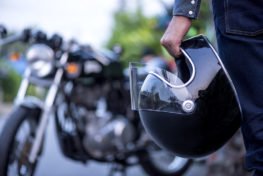
There’s an old saying that “four wheels move the body; two wheels move the soul.” Whether you’re a seasoned biker or are just considering buying your first motorcycle, it’s easy to understand the allure. The freedom, the rush of wind on your face, and the thrill of the open road—all of these contribute to the draw of motorcycling. But with this excitement comes a harsh reality: motorcycles are inherently more dangerous than other forms of transportation.
In fact, motorcycle accidents account for a disproportionate number of traffic fatalities in the United States. In 2020, according to the National Highway Traffic Safety Administration (NHTSA), there were 5,579 motorcyclist fatalities—an increase of nearly 9% from the previous year. Despite representing just 3% of all registered vehicles in the U.S., motorcycles make up 14% of all traffic deaths. These sobering statistics are a reminder of just how important it is for motorcyclists to prioritize safety—and nothing is more crucial to that than wearing a helmet.
Motorcycle Accidents in Texas: A Serious Concern
Texas, with its vast open roads and warm climate, is a hotspot for motorcyclists. However, it also has some of the highest rates of motorcycle accidents in the nation. In 2020, the Texas Department of Transportation (TxDOT) reported that 412 motorcyclists lost their lives in crashes. That same year, motorcycle crashes in Texas also resulted in nearly 1,800 injuries. Sadly, many of these accidents could have been mitigated by taking basic safety precautions, including wearing a helmet.
In response to this alarming data, TxDOT continues to promote its statewide “Share the Road” campaign, which encourages all drivers to exercise extra caution around motorcyclists. The campaign emphasizes two primary causes of motorcycle accidents: collisions at intersections and lane-change accidents. Both are areas where motorcyclists are most vulnerable, and both require greater awareness from all road users.
Texas Helmet Laws: What You Need to Know
Motorcycle helmet laws vary by state, and Texas is one of the few states that offers some flexibility. Under Texas law, motorcyclists and passengers are required to wear helmets—but there are exceptions. Specifically, riders who are 21 years or older can legally ride without a helmet if they meet one of two conditions:
- They have health insurance that provides at least $10,000 in medical coverage for injuries sustained while riding a motorcycle.
- They have completed a state-approved motorcycle safety course.
However, while Texas law allows for some leeway, the importance of wearing a helmet cannot be overstated. According to the NHTSA, helmets are approximately 37% effective at preventing deaths in the event of a motorcycle crash and 67% effective at preventing brain injuries. Even if you’re legally permitted to ride without one, the risks associated with skipping a helmet are simply not worth it.
The Case for Helmets: Life-Saving Benefits
Motorcycle helmets are one of the most effective tools in preventing serious injury and saving lives. According to the NHTSA’s most recent data, helmets saved an estimated 1,872 lives in 2020 alone. More importantly, helmets are not just about reducing the risk of death—they can also prevent catastrophic brain injuries. A study published by the CDC found that motorcyclists who do not wear helmets are three times more likely to suffer brain injuries in the event of a crash.
The numbers are clear: wearing a helmet is one of the simplest and most effective ways to protect yourself while riding. Even a seasoned rider with years of experience is at risk of a crash. No one is immune to the unpredictable nature of traffic, and the consequences of riding without a helmet are far too severe to ignore.
Choosing the Right Helmet: What to Look For
If you’re going to wear a helmet—and you should—it’s essential to choose one that meets safety standards. Not all helmets are created equal. A helmet that doesn’t meet basic safety guidelines may offer little protection in the event of a crash. The NHTSA has outlined several important factors to consider when selecting a helmet:
- Thick Inner Liner: Helmets meeting the Federal safety standards have a firm, polystyrene foam inner liner that is at least one inch thick. This material helps absorb the impact energy in the event of a crash, reducing the risk of serious injury. Helmets without an inner liner or with insufficient padding may not provide adequate protection.
- Sturdy Chin Strap and Rivets: The chin strap ensures that the helmet stays securely on your head during a crash. A helmet with a weak or poorly attached chin strap may come off, leaving your head exposed. Make sure the chin strap is made of durable material, and check that the rivets securing it are solid.
- Weight of the Helmet: Helmets that meet safety standards usually weigh around three pounds. While lighter helmets may seem more comfortable, they often don’t offer the same level of protection as standard helmets. If a helmet feels excessively light, it may not meet safety guidelines.
- DOT Sticker: Helmets that meet the Federal Motor Vehicle Safety Standards (FMVSS) 218 should have a Department of Transportation (DOT) sticker on the back. This indicates that the helmet has passed rigorous safety testing. Avoid helmets without this sticker, as they may not provide sufficient protection.
- Additional Certifications: Some helmets may also be certified by non-profit organizations such as Snell or the American National Standards Institute (ANSI). These organizations have higher safety standards than the basic federal requirements, so look for a helmet with an additional certification sticker for extra peace of mind.
- Manufacturer’s Label: Helmets that meet the federal standards should include a label inside with the manufacturer’s name, model, size, and the date of manufacture. This label ensures that the helmet complies with all necessary safety regulations. Always check for this label to ensure the helmet is safe.
Safety First: The Financial and Health Implications
While the financial cost of purchasing a helmet may seem like an inconvenience, the reality is that wearing a helmet is an investment in your well-being. Medical bills for brain injuries can quickly add up to tens or even hundreds of thousands of dollars—far more than the price of a high-quality helmet. In fact, the cost of a helmet is a fraction of what you could end up paying for treatment, lost wages, and long-term care if you sustain a head injury in an accident.
Additionally, even if you’re not concerned about the financial costs, there’s the question of your health and quality of life. Traumatic brain injuries can have life-altering consequences, including long-term cognitive impairment, physical disabilities, and emotional or psychological trauma. These injuries are often preventable by simply wearing a helmet.
The Bottom Line: Why Safety Should Be Your Priority
Motorcycle safety is not something that should be taken lightly. While riding a motorcycle is exhilarating and offers a sense of freedom, it’s also important to recognize the risks. Helmets have been proven time and time again to save lives, reduce brain injuries, and improve outcomes in the event of a crash.
In Texas, the law provides exceptions for riders over 21 who wish to forgo wearing a helmet, but the statistics and research make it clear that the risks of not wearing one are simply too high. Whether you are legally required to wear a helmet or not, choosing to ride without one is a gamble with your life.
The cost of a helmet is negligible compared to the potential consequences of a crash, and the safety it provides is invaluable. Helmets are the most effective and affordable form of insurance available to motorcyclists. If you value your life and health, there should be no debate: always wear a helmet when riding.
Your Head is Worth Protecting
The simple truth is this: riding without a helmet is not worth the risk. Helmets are proven to save lives, and they are essential for protecting your head, your brain, and your future. As you gear up for your next ride, make the choice to protect yourself and ride safely.
Motorcycling is an incredible experience, but it’s important to remember that the most essential piece of safety equipment you need is the one that fits on your head. Make sure you wear a DOT-approved helmet, check for proper certifications, and never underestimate the importance of this life-saving gear.
Stay safe, ride responsibly, and always remember: your head is worth protecting.
CONTACT HERRMAN & HERRMAN IF YOU HAVE BEEN INJURED IN ANY OF THE FOLLOWING TYPES OF ACCIDENTS:
Our Texas personal injury lawyers help clients who have suffered injuries in various accidents.
We can help you if you have been harmed by the following:
- Car accidents – Our lawyers have extensive experience handling car accident cases. We will work to identify the party or parties at fault for the crash and build a case to demonstrate persuasively how the parties caused the accident and your injuries. We will seek fair and full compensation through a negotiated settlement or at trial if necessary.
- Truck accidents – Thousands of large commercial trucks travel the roads of Texas every single day. Unfortunately, careless truck drivers and trucking companies disregarding safety put innocent people at risk of serious injuries. If you’ve been injured in a truck accident, let our experienced Texas personal injury lawyers stand up to the trucking companies and insurers on your behalf.
- Motorcycle accidents – Motorcycle riders often suffer grievous injuries in crashes caused by other motorists. Too many motorcycle accidents in Corpus Christi are caused by careless drivers who don’t look for motorcycle riders or violate their right of way. Our personal injury lawyers will work to cut through the bias and stigma against motorcycle riders. Our goal is to seek the financial compensation that you’ll need to recover from a serious motorcycle accident and injuries such as bone fractures, road rash, or traumatic brain injury.
- Product liability – Product manufacturers have a legal obligation to make products that are safe for their intended uses and to warn consumers of any risks that may come with the product. When products have design or manufacturing defects or undisclosed dangers, the product manufacturer may be legally responsible for injuries suffered by consumers. Our attorneys can help you evaluate whether you have a valid product liability claim.
- Brain injury – Brain injuries can leave accident victims with disabilities that leave them unable to work or perform many tasks of daily living. Seeking compensation for a brain injury in an accident often proves incredibly complex. The brain injury survivor may seek compensation for anticipated future medical care and the medical care already provided. Our personal injury lawyers can help you through the difficult recovery process following a brain injury and will fight to make sure you have the resources you need.
- Spinal injury – Spinal cord injuries could cost millions of dollars of care over the course of the victim’s lifetime, especially when those injuries result in partial or complete paralysis, such as paraplegia or quadriplegia. If you or your loved one has suffered a spinal cord injury, you deserve compassionate legal representation. Our attorney can help you determine whether you may be entitled to claim compensation for your injury and expenses related to living with the disability, such as making a home more accessible.
- Wrongful death – If you have lost a loved one due to the negligent or reckless actions of another party, your family deserves to seek accountability and compensation from those at fault for the wrongful death. Our caring and dedicated attorneys can help guide you and your family through this difficult and painful time and seek justice for your loved one.








